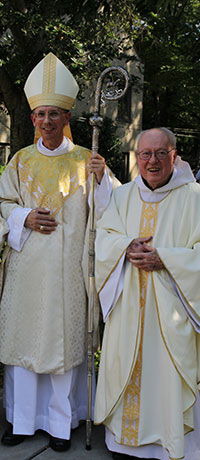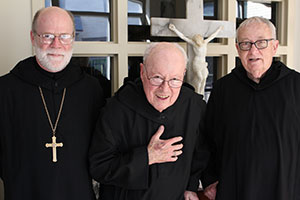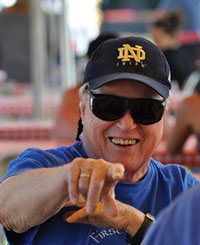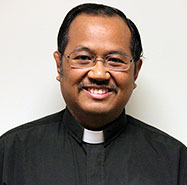 Father Kieran Neilson, O.S.B., with Bishop Peter Jugis at the 2015 Jubilarians Mass. BELMONT — Benedictine Father Kieran A. Neilson died peacefully at Belmont Abbey on Wednesday, Feb. 27, 2019, strengthened by the sacraments. He was 86.
Father Kieran Neilson, O.S.B., with Bishop Peter Jugis at the 2015 Jubilarians Mass. BELMONT — Benedictine Father Kieran A. Neilson died peacefully at Belmont Abbey on Wednesday, Feb. 27, 2019, strengthened by the sacraments. He was 86.
The Benedictine served for nearly 60 years as a priest.
His body will be received at the abbey on Friday evening, March 1, in the Basilica of Our Lady, Help of Christians, located at 100 Belmont Mount Holly Road in Belmont, at 7 p.m., followed by Vespers.
The funeral Mass will be celebrated at St. Michael Church, 708 St. Michael's Lane in Gastonia, on Saturday morning, March 2. The rosary will be at 9:40 a.m., followed by Mass at 10 a.m. Interment follow at the Belmont Abbey Cemetery.
Alexander Patrick Neilson, known as Paddy to his family and friends, was born on July 2, 1932, in Charlotte, the son of the late Alexander J. and Catherine Jones Neilson.
He attended O’Donoghue School in Charlotte for his elementary and secondary education, testing the patience and skill of the Sisters of Mercy, to whom he remained devoted throughout his life. He graduated from Belmont Abbey College in 1954 and entered the novitiate, receiving the name Kieran in honor of his Irish heritage. He was professed on July 2, 1955. After studies at the Belmont Abbey Seminary, he was ordained a priest on May 26, 1960.
In North Carolina, Father Kieran served at various times as subprior and formation director in the monastic community, as chaplain at Belmont Abbey College, instructor at Sacred Heart College and parochial vicar at St. Michael Parish in Gastonia. He was assigned to St. Benedict Priory in Richmond, Va., from 1960 to 1965, and again from 1976 to 1989, serving at St. Benedict’s Parish and Benedictine High School and as chaplain at McGuire Veterans Hospital.
When the Richmond community became independent in 1989, Father Kieran returned to Belmont Abbey and his family in Charlotte. He was a beloved presence on campus, a popular figure and well known among students, who were drawn to his cheerful smile, hearty laugh and warm nature. This past spring, he celebrated the 59th anniversary of his ordination.
Growing up in the small Catholic community in Charlotte, Father Kieran was acquainted with the monks of Belmont Abbey from his youth. After God, Father Kieran loved his large extended family, his Irish heritage and Notre Dame athletics.
Father Kieran cherished a life-long love of automobiles, which he indulged on a daily basis. At one point, he had a car donated for his personal use, which he parked at a discreet distance from the monastery – a happy situation which met with an infelicitous end when it became known to the abbot. Benedictine Father Kieran Neilson (center) with Abbot Placid Solari and Father David Kessinger in 2015.
Benedictine Father Kieran Neilson (center) with Abbot Placid Solari and Father David Kessinger in 2015.
He was an outgoing, friendly man with an extensive circle of loyal friends. His wide-ranging travels and gregarious nature made him the abbey’s best-known monk and goodwill ambassador. He had a nickname for everyone and was not shy with his comments and remarks.
For more than 50 years he served as a monk and priest at the abbey. Father Kieran had particularly fond memories of his early days at the abbey including the farm, which the monks tended during the 1950s and early 1960s on a plot of land directly adjacent to the monastery.
When he wasn't tending to the farm, Father Kieran taught sociology and theology at the Sacred Heart campus in Belmont. At one point he acted as the resident disciplinarian at Benedictine College Preparatory School in Richmond, Va. "I saw those young men later grow up as doctors and such; and they came back to see me with their children and thanked me for what I did for them. That's what really makes me feel good," said Father Kieran when asked about his time in Richmond.
In an interview in 2015, Father Kieran said it was the happiness he received from knowing the good he had that gave him the most satisfaction. "What is so wonderful for me about my life so far is the people I served over those years – the joy they gave me in being able to minister to them. That's something I'll never lose sight of and never forget."
In addition to his parents, Father Kieran was preceded in death by his brothers Joseph and John. He is survived by the monks of Belmont Abbey, by his sisters, Kathleen Potter, Mary Ann Frantz and Patricia Neilson, and by his large extended family.
— Catholic News Herald. Photos by SueAnn Howell, senior reporter.
The following is a reflection from Father Kieran’s niece Ann Potter Gleason:
The Box: Joy in life comes from living for others
 He handed me a cardboard box. “I want you to keep this,” he almost whispered. “I don’t want them throwing it away when I’m gone.” It wasn’t a big box, but for my uncle, Father Kieran Neilson, a monk of Belmont Abbey, it held a treasure because of what its contents represented—a life lived for others, a life of laughter, of love, of true relationships. That tattered container held hundreds of photographs, many faded, most of people I’d never met. “Can you imagine what it’d have been like if I’d had an iPhone,” he chuckled. Although “Uncle Paddy,” as he was known in the Neilson family, took a vow of poverty, he was the richest man I’ve ever known. And although he took a vow of stability, he had friends all over the world. Why?
He handed me a cardboard box. “I want you to keep this,” he almost whispered. “I don’t want them throwing it away when I’m gone.” It wasn’t a big box, but for my uncle, Father Kieran Neilson, a monk of Belmont Abbey, it held a treasure because of what its contents represented—a life lived for others, a life of laughter, of love, of true relationships. That tattered container held hundreds of photographs, many faded, most of people I’d never met. “Can you imagine what it’d have been like if I’d had an iPhone,” he chuckled. Although “Uncle Paddy,” as he was known in the Neilson family, took a vow of poverty, he was the richest man I’ve ever known. And although he took a vow of stability, he had friends all over the world. Why?
Because of his joy and his rare gift for just being present to everyone he met, for connecting with people of all kinds, old and young, rich and poor. He received each one into his heart, as the Rule of St. Benedict teaches, like he was receiving Christ.
Uncle Paddy passed away on February 27, 2019, after 6 years of battling cancer. He was ready to go home to his Heavenly Father. He knew his earthly journey was ending when he handed me that box in January, but you could still sense the pain he felt parting from so many friends.
According to my mom, his older sister, Kathleen, the man we all knew was the same as the boy who frolicked and made mischief around Dilworth in the 1930s and 40s. He befriended all the neighbors, and everyone loved him. He took a real interest in people, which is different from just a curiosity because it entails compassion, a true eagerness to understand and share in the feelings of another. Getting to know another person was not a means to an end for Uncle Paddy. It was an end in itself.
An afternoon outing with Uncle Paddy was a little like an afternoon with Mary Poppins.Because everyone knew him, all sorts of doors would open, and adventure awaited behind each one. During a pilgrimage to Fatima in the 1980s, I once joined him for a morning run. As he jogged through the village streets calling, “Bone Diah!” with his characteristic southern drawl, it was apparent that he’d already made the acquaintance of half the shop owners.
Before I knew it, we were whisked into a café and seated at a table spread with pastries and coffee, special guests of the cafe’s Portuguese proprietor. Uncle Paddy’s warmth and zeal needed no translation.
Although his travels took him to numerous countries and fascinating places, upon his return my uncle would speak only sparingly of the historic sites and majestic beauty he’d beheld. Instead, his eyes would twinkle with life as he’d tell you about the people he’d met.
After his trip to the Holy Land, I heard all about the tour guide, the bus driver, and their families.
They had obviously touched him. And, no doubt, he’d touched them.
Uncle Paddy could speak frankly. His playful jabs could sting. “John, you’re lookin’ portly!” he quipped to my teenage son who had put on a few pounds. But the foundational relationship of love and affection that had been built over the years preceding that comment mitigated any offense. Rather than fodder for resentment, such incidents became just another
“Uncle Paddy Story.” Every member of the extended Neilson family has several.
I don’t know if Uncle Paddy ever texted or tweeted or created a Facebook page, but I know he was “connected”—profoundly connected. Like Christ, his deep joy and unwavering hope attracted souls. He lived for others, and they knew it.
So I’ll keep that box entrusted to me in January. I’ll hold it dear not because I know the faces or share the memories reflected in those photos, but because it will always remind me of
Uncle Paddy and the lesson he taught me: The joy in life comes from living for others. The joy in life comes from living with the heart of Christ. John 15:11-13.
Saying goodbye to a monk
On his deathbed my father could barely speak because he was on a respirator, so he began writing notes, trying to tie up the loose ends of his life in his final hours. One of his notes read: “Please tell the men of Belmont Abbey thank you.”
My father had been placed at the Benedictine monastery just outside of Charlotte in 1926 when he was 13, right after his mother had died. He lived there until he was 19, through his impressionable teenage years until adulthood. He was always grateful to have been formed in his faith by the monks of the monastery. Throughout his adult life Dad supported the monastery and college and counted many of the monks as his closest friends. He called the Abbey his mother. The Abbey became, for my brothers and me, our grandmother.
Because we have been close to the monks, we have attended a number of funerals there: cherished abbots of old, college professors, dear friends. Members of my family, including my mother and father, rest in the hallowed ground of that cemetery. An Abbey monk who helped saved my life lay there, as well as the one who dispensed the Blessed Sacrament to me in my first Holy Communion. I have said goodbye to teachers and confessors and counselors and confidants.
The other day I stood again in that cemetery, watching the simple black casket of the Benedictines being lowered into the ground as the monks sang in unison: “Ultima in mortis hora, Filium pro nobis ora, Bonam mortem impetra, Virgo Mater Domina.” (“When death’s hour is then upon us, to your Son pray that He grant us death both holy and serene, Virgin Mary, Mother Queen.”) That solemn Latin chant by a handful of brother monks at a graveside is as poignant a moment as I know. They were saying goodbye to one of the most joyful, colorful and all round influential monks in the abbey, Father Kieran “Paddy” Neilson.
Aside from his teaching duties over the years and various positions within the monastic community, Father Kieran was a welcome sight for decades around the campus and on the monastery grounds. He was a beloved figure to many people of our area as well as in Richmond, at the Benedictine high school where he taught for many years.
Everybody has a Father Kieran story. One of mine is about the time I was helping to teach confirmation students at St. Patrick Cathedral in Charlotte. I was determined to bring in a good, holy priest to every class to talk to the kids. Father Kieran, who grew up two houses away from the cathedral, walked with me from the church down to the cafeteria of St. Pat’s School where the class was assembled. Before we got there, I said, “Father, when I bring a priest in, I’ve been telling the kids a little about him personally – you know, perhaps something about his family or his hobbies.” Before I could take another step, in his fine Southern drawl, he replied, “Aw, Freddy! Hobbies? That’s easy… prayer and sports! Prayer and sports!” He kept up a running commentary on his beloved Notre Dame football team, among other favorites, and would unleash his particular critical insights completely unsolicited.
Father Kieran was a treasured chaplain to the Abbey college students. This happy, mischievous, animated and friendliest of clerics who never forgot a name was a model of that concrete holiness that showed everyone the sanctity of daily life, even in the infirmity of his later years.
Every hymn at Father Kieran’s funeral was of Celtic origin in tribute to his Irish heritage. In his homily, Abbot Placid mentioned that Father Kieran had been lobbying for another trip to the Emerald Isle, even though he was too sick to travel. And in a striking example of God’s inspiring order, Abbot Placid also recalled that he had received his own first Holy Communion from Father Kieran in Richmond. The abbot said he had known Father Kieran since he was 6 years old.
In a time when clergy scandals continue to bruise us all (it seems like almost every church has been touched by them, including Belmont Abbey), I pray for its victims and fight the horrors of it with recollections of the many good and holy men of the priesthood and women religious who helped to form me in my faith and witnessed to a sacramental way of living.
We can combat the scandals with thousands of examples of godly faith, compassion and holiness like that I have encountered in the gifts God has granted me through certain people in my life – people like Father Kieran “Paddy” Nielson. And so I bid a fond farewell to a wonderful monk.
Fred Gallagher is an author and editor-in-chief with Gastonia-based Good Will Publishers Inc.
 MORGANTON — Deacon Paul (Pe) Lee passed away Wednesday, Oct. 17, 2018. At the time of his passing, Deacon Paul was a resident of Morganton.
MORGANTON — Deacon Paul (Pe) Lee passed away Wednesday, Oct. 17, 2018. At the time of his passing, Deacon Paul was a resident of Morganton.
A Hmong vigil and visitation will be held from noon to 9 p.m. Friday, Nov. 16; 9 a.m. to 9 p.m. Saturday, Nov. 17; and 9 a.m. to 9 p.m. Sunday, Nov. 18, at Kirksey Funeral Home, located at 406 Lenoir Road in Morganton. Visitation will also be held from 10 to 10:45 a.m. Monday, Nov. 19, at St. Charles Borromeo Church, located at 728 West Union St. in Morganton.
A funeral Mass will be offered at 11 a.m. Monday, Nov. 19, at St. Charles Borromeo Church.
A native of Laos, Deacon Paul and his wife Shoua migrated to the United States as part of the Hmong refugee program in 1991.
Deacon Paul was born into a Catholic family in 1964. However, because of conflict in Laos, his village was destroyed and his family had to relocate many times. They had no access to a priest or lay catechist and it was not until he was 6 that Deacon Paul was finally baptized.
In May 1975 his family was forced to leave Laos and they became refugees in Thailand. In 1979, he received the sacraments of first Holy Communion and confirmation at the same time. He was taught by a local Hmong catechist, and at the age of 15 he began to realize the importance of Jesus Christ in the lives of people. It was then that Deacon Paul believed that the Holy Spirit was calling him. He had the desire to know God better and he wanted to serve God through his own Hmong people.
He never forgot the catechist who taught him about his faith. In his own words, he said, “I want to be that man. I like this job like the catechist.” He told the catechist he wanted to be a catechist and entered the catechist training class.
He studied for four years and then served as a catechist for six years in the refugee camp in Thailand. He taught new members of the faith the sacraments, served the sick, visited the imprisoned, helped those needing food and shelter and led worship services on Sundays when the priest was not available. It was during this time in 1986 after a year of courtship that Deacon Paul and his wife Shoua were married at St. Michael Church in the refugee camp and started their family of five children – two girls and three boys.
After immigrating to the United States in 1991, he continued his efforts for the Hmong community in California for eight years. During this time, he learned English, earned his high school diploma and supported his family. In 1999, Deacon Paul moved his family to Morganton.
He was hired by the Diocese of Charlotte to serve the Hmong Catholic community, and he served as a Hmong catechist under the direction of Father Bill Tanguay in Morganton, Hickory, Conover, Newton, Charlotte and Albemarle.
In July 2002, he was accepted into and began his formation studies for the permanent diaconate for the Diocese of Charlotte. Upon completing formation, Deacon Paul was one of 16 men ordained for the Diocese of Charlotte in 2006.
His assignment as a deacon was to support the Hmong community within parishes throughout the diocese. He traveled among the different parishes, serving at Mass and supporting the family needs of the Hmong community.
Deacon Paul and his wife Shoua shared so much of their faith together within the Hmong community and with everyone in the diocese. While he served as a deacon, his wife led the singing and responses at Mass. They were an example of what it meant to share God’s work together as a couple and with their family. In many ways, they ministered together. They were a blessing to the diocese in bringing the Catholic faithful together in sharing the traditional Hmong New Year and at other parish cultural events during the year.
In his many years of service as a catechist and in his 12 years of diaconate ministry, Deacon Paul was relentless in his call to serve the Lord. Through his efforts the Hmong community received the Gospel of Christ not only in words, but in the actions of a holy man dedicated to the service of God, to his community and to all of us.
Kirksey Funeral Home of Morganton was in charge of the arrangements.
— Deacon John Martino, Special to the Catholic News Herald

